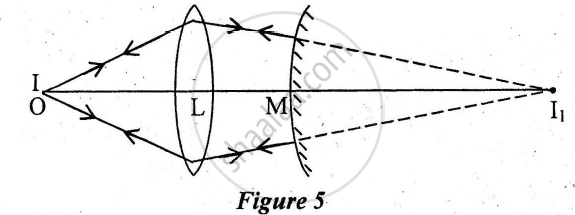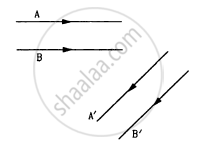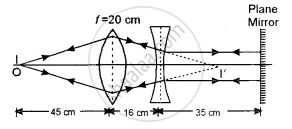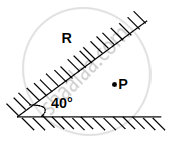Advertisements
Advertisements
प्रश्न
A light ray, going through a prism with the angle of prism 60°, is found to deviate by 30°. What limit on the refractive index can be put from these data?
उत्तर
Given,
The angle of the prism (A) = 60˚
The angle of deviation (δm) = 30˚
\[Refractive index, \]
\[ \mu \leq \frac{\sin\left( \frac{A + \delta_m}{2} \right)}{\sin\left( \frac{A}{2} \right)}\]
\[\mu \leq \frac{\sin\left( \frac{60^\circ + \delta_m}{2} \right)}{\sin\left( \frac{60^\circ}{2} \right)}\]
\[\mu \leq 2\sin\left( \frac{60^\circ\ + \delta_m}{2} \right)\]
As there is one ray that has been found which has deviated by 30˚, the angle of minimum deviation should be either equal to or less than 30˚ but it can not be more than 30˚.
Therefore,
\[\mu \leq 2\sin \left( \frac{60^\circ + \delta_m}{2} \right)\]
\[\mu \leq 2\sin \left( \frac{60^\circ \ + 30^\circ}{2} \right) = 2\sin \left( 45^\circ\ \right)\]
Refractive index (μ) will be more if angle of deviation (δm) is more.
\[\mu \leq 2 \times \frac{1}{\sqrt{2}}\]
\[\Rightarrow \mu \leq \sqrt{2}\]
Hence, the required limit of refractive index is \[\sqrt{2}\]
APPEARS IN
संबंधित प्रश्न
Calculate the distance of an object of height h from a concave mirror of radius of curvature 20 cm, so as to obtain a real image of magnification 2. Find the location of the image also.
a) Give two reasons to explain why reflecting telescopes are preferred over refracting type.
Use the mirror equation to show that a convex mirror always produces a virtual image independent of the location of the object.
Use the mirror equation to deduce that an object placed between the pole and focus of a concave mirror produces a virtual and enlarged image.
An object is kept on the principal axis of a concave mirror of focal length 10 cm. at a distance of 15
cm from its pole. The image formed by the mirror is:
(a) Virtual and magnified
(b) Virtual and diminished
(c) Real and magnified
(d) Real and diminished
A point object O is placed at a distance of 15cm from a convex lens L of focal length 1 Ocm as shown in Figure 5 below. On the other side of the lens, a convex mirror M is placed such that its distance from the lens is equal to the focal length of the lens. The final image formed by this combination is observed to coincide with the object O. Find the focal length of the convex mirror

Define the term 'limit of resolution'?
following Figure shows two rays A and B being reflected by a mirror and going as A' and B'. The mirror
A cylindrical vessel of diameter 12 cm contains 800π cm3 of water. A cylindrical glass piece of diameter 8.0 cm and height 8.0 cm is placed in the vessel. If the bottom of the vessel under the glass piece is seen by the paraxial rays (see figure), locate its image. The index of refraction of glass is 1.50 and that of water is 1.33.

A small object is placed at the centre of the bottom of a cylindrical vessel of radius 3 cm and height 4 cm filled completely with water. Consider the ray leaving the vessel through a corner. Suppose this ray and the ray along the axis of the vessel are used to trace the image. Find the apparent depth of the image and the ratio of real depth to the apparent depth under the assumptions taken. Refractive index of water = 1.33.
Find the maximum angle of refraction when a light ray is refracted from glass (μ = 1.50) to air.
The figure below shows the positions of a point object O, two lenses, a plane mirror and the final image I which coincides with the object. The focal length of the convex lens is 20 cm. Calculate the focal length of the concave lens.

A parallel beam of light is allowed to fall on a transparent spherical globe of diameter 30cm and refractive index 1.5. The distance from the centre of the globe at which the beam of light can converge is ______ mm.
Car B overtakes car A at a relative speed of 40 ms-1. How fast will the image of car B appear to move in the mirror of focal length 10 cm fitted in car A, when car B is 1.9 m away from car A?
When a clock is viewed in a mirror, the needles exhibit a time which appears to be 8:20. Then the actual time will be:
Two plane mirrors are inclined at an angle of 40°. The possible number of images of an object placed at point P would be?

